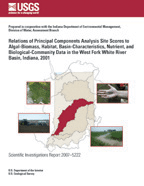Publications—Scientific Investigations Report 2007-5222
By Brian J. Caskey, Jeffrey W. Frey, and B. Scott Lowe
 |
This Report is available Online Only Front Cover - PDF format (910 KB)
|
Data were gathered from July through September 2001 at 34 randomly selected sites in the West Fork White River Basin, Indiana for algal biomass, habitat, nutrients, and biological communities (fish and invertebrates). Basin characteristics (drainage area and land use) and biological-community attributes and metric scores were determined for the basin of each sampling site. Yearly Principal Components Analysis site scores were calculated for algal biomass (periphyton and seston). The yearly Principal Components Analysis site scores for the first axis (PC1) were related, using Spearmanís rho, to the seasonal algal-biomass, basin-characteristics, habitat, seasonal nutrient, biological-community attribute and metric score data.
The periphyton PC1 site score, which was most influenced by ash-free dry mass, was negatively related to one (percent closed canopy) of nine habitat variables examined. Of the 43 fish-community attributes and metric scores examined, the periphyton PC1 was positively related to one fish-community attribute (percent tolerant). Of the 21 invertebrate-community attributes and metric scores examined, the periphyton PC1 was positively related to one attribute (Ephemeroptera, Plecoptera, and Trichoptera (EPT) index) and one metric score (EPT index metric score). The periphyton PC1 was not related to the five basin-characteristic or 12 nutrient variables examined. The seston PC1 site score, which was most influenced by particulate organic carbon, was negatively related to two of the 12 nutrient variables examined: total Kjeldahl nitrogen (July) and total phosphorus (July). Of the 43 fish-community attributes and metric scores examined, the seston PC1 was negatively related to one attribute (large-river percent). Of the 21 invertebrate-community attributes and metric scores examined, the seston PC1 was negatively related to one attribute (EPT-to-total ratio). The seston PC1 was not related to the five basin-characteristics or nine habitat variables examined.
To understand how the choice of sampling sites might have affected the results, an analysis of the drainage area and land use was done. The 34 randomly selected sites in the West Fork White River Basin in 2001 were skewed to small streams. The dominant mean land use of the sites sampled was agriculture, followed by forest, and urban.
The values for nutrients (nitrate, total Kjeldahl nitrogen, total nitrogen, and total phosphorus) and chlorophyll a (periphyton and seston) were compared to published U.S. Environmental Protection Agency (USEPA) values for Aggregate Nutrient Ecoregions VI and IX and Level III Ecoregions 55 and 72. Several nutrient values were greater than the 25th percentile of the published USEPA values. Chlorophyll a (periphyton and seston) values were either greater than the 25th percentile of published USEPA values or extended data ranges in the Aggregate Nutrient Ecoregions and Level III Ecoregions. If the proposed values for the 25th percentile were adopted as nutrient water-quality criteria, many samples in the West Fork White River Basin would have exceeded the criteria.
Abstract
Introduction
Purpose and Scope
Description of the West Fork White River Basin
Study Methods
Site Selection and Sampling Strategies
Algal-Biomass, Habitat, Nutrient, and Biological-Community Data-Collection and Processing Methods
Data Analysis
Basin-Characteristics Data
Nutrient Data
Principal Components Analysis
Comparison With U.S. Environmental Protection Agency Data
Relations of the Principal Components Analysis Site Scores to Algal-Biomass, Habitat,
Basin-Characteristics, Nutrient, and Biological-Community Data
Drainage-Area and Land-Use Analysis
Comparison of the Data to Ecoregion Nutrient Criteria
Conclusions
Acknowledgments
References
Appendix 1
Frey, J.W., Caskey, B.J., and Lowe, B. S., 2007, Relations of Principal Component Analysis site scores algal-biomass, habitat, basin-characteristics, nutrient, and biological community data in the West Fork White River Basin, Indiana, 2001: U.S. Geological Survey Scientific Investigations Report 2007–5222, 25 p.
If you have Adobe Acrobat® or Adobe Acrobat Reader® installed on your computer, you may view and print the PDF version of this report. Acrobat Reader, is a free download from Adobe Systems, Inc. Users with disabilities can view information concerning accessibility at access.Adobe.com .